
Hole-in-Donut restoration moves forward
The national parks in the United States have long served as beacons of history, patriotism and diversity.
The pride that comes from the existence of these parks is unmatched, as they provide Americans with views into the past and symbols of culture as well as astounding nature.
That’s why preservation of the national parks is so important. Preserving our parks means appreciation for nature and history are passed on to future generations.
| An aerial view of the 6,300 acres that make up the Hole-in-Donut. So far, 4,800 have been restored (Photos courtesy of the National Park Service). | 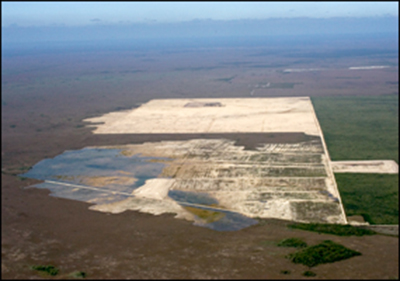 |
Preservation entails historians, architects, archeologists, and other experts to serve and protect the lands and share their rich history. These employees of the National Park Service work with states, local governments, Native American tribes, and nonprofit organizations to protect the parks and thus our heritage.
According to the National Park Service, there are 27,000 significant structures and 66,000 archeological sites in national parks. A total of $1.2 billion has been spent in preservation grants and $30 billion in historic rehabilitation tax credit projects.
One of the nation’s beloved parks benefitting from this help is located in sunny Florida. The Everglades National Park has been named America’s largest subtropical wilderness.
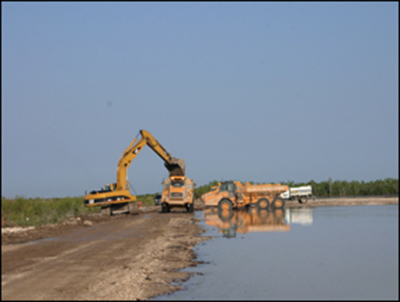 |
Mechanically removing the damaged soil and Brazilian Pepper trees back to the native limestone bedrock allows for natural vegetation to colonize and grow. |
With its unique ecosystem consisting of marshes, mangroves, alligator holes and tropical fauna, it is both special and in danger.
Specifically, there are 6,300 acres of former agricultural lands that have been severely damaged. The acres are located near Paradise Key in the Royal Palm area, about three miles past the park’s main entrance which is 45 miles south of Miami. These parcels of land were heavily farmed and then abandoned in 1975.
The disturbed soil led to the invasion of the harmful Brazilian pepper, a non-native species that grew aggressively and took over the native vegetation.
Dubbed the Hole-in-Donut because of its location surrounded by native communities, this area of wetlands has gotten the attention it deserves. A restoration project has been implemented to remove the Brazilian pepper and the damaged soil so that native plants can colonize and the natural hydrology of the area may be restored.
| Park employees help the restoration effort by reintroducing native trees. | 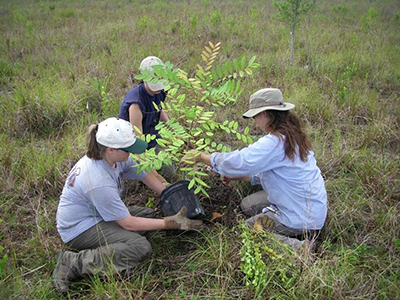 |
Though restoration has been well underway, it took a decade of planning, field experiments and reports to begin the HID Restoration Project.
According to Linda Friar, Everglades National Park spokesperson, the process requires several steps.
“Miami-Dade County must permit development and then require any wetland destruction in development to invest a set formula of impact costs to improve a larger wetland,” Friar explained.
This means that the county must first allow the restoration process to begin and then must calculate the costs in developing a restored wetland area.
Friar added that the partnership between the park and Miami-Dade County has worked very well.
Also helping the HID Restoration Project are various organizations such as the Florida Department of Environmental Protection, the U.S. Army Corps of Engineers, and the National Park Service, which has donated $67 million to the effort.
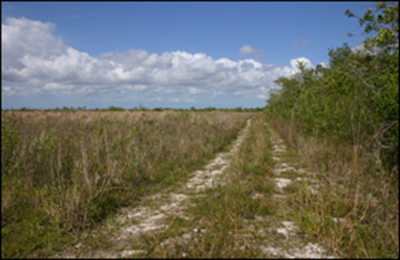 |
In the photo at the left, restored lands of marl prairie are seen on the left of the road while, on the right side, it is clear to the dense Brazilian pepper awaiting upcoming removal. Below, sawgrass, one of the HID’s native plants, has reestablished itself in the area following restoration. |
The National Park Service lists five broad goals of the HID Restoration Project, which are:
“Define and characterize the structure and function of native communities as reference systems
- “Permanently remove invasive exotics from the Hole-in-the-Donut and restore a self-sustaining ecosystem
- “Integrate research, monitoring, and management
- “Fund research relevant to restoration that may also be applicable to other restoration questions and programs
- “Evaluate cost-effective restoration alternatives
- “Ensure feedback of research findings to the management decision-making process (adaptive management)”
The process for restoring the Hole-in-Donut involves various steps.
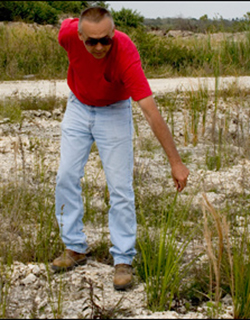 Jonathan Taylor, the Natural Restoration Program manager who works at the Daniel Beard Center of Everglades National Park, explained the method.
Jonathan Taylor, the Natural Restoration Program manager who works at the Daniel Beard Center of Everglades National Park, explained the method.
“It begins by chopping down the vegetation into small and manageable pieces then scraping that cut material and the soil in which it was growing in into piles,” said Taylor.
The soil, which is six to 12 inches deep before hitting solid rock, is stored in mounds. Once the materials have been moved to limestone rock, the restoration technique is completed.
After this, Taylor explained that the last step simply involves “watching the native plants grow back in. Removing the chipped material restores the natural hydrology to the area and that restored hydrology and the soil that has been removed allows for the establishment of plants to colonize the site and grow into a healthy native wetland.”
Taylor says that the type of equipment used for the restoration method include bulldozers, dump trucks, front end loaders, sweepers and graters, basically typical construction equipment.
So far, 4,800 acres out of the 6,300 have been restored. And fortunately, the restoration of these wetlands also affects the habitats surrounding them.
“Returning disturbed land to sawgrass marsh helps the system function more like it did historically,” Friar explained. “This improves the overall health of the area under renovation and those lands adjacent.”
Restoration of the Hole-in-Donut continues. According to their website, following restoration the National Park Service predicts “communities of short-to-medium hydro-period prairie developing within the first year. Wildlife, such as wading birds and deer, will return to the area to forage for food and leave seeds behind in their waste, helping to reestablish native vegetation.”
As for the future of the HID as well as the Everglades National Park as a whole, park spokesperson Friar believes that “the park is dedicated to working with our neighboring jurisdictions to improve the health of the greater Everglades ecosystem.”
If You Go
Call Everglades National Park at 305-242-7700, to learn more about the Hole-in-Donut as well as visiting the site. Also, get information on fees and reservations as well as brochures, tours, and activities that include biking, hiking, boating and bird watching.
Visit: http://www.nps.gov/ever/index.htm and for specific tours and booking: http://www.evergladestours.org/?event=offer.list&p=9&gclid=CKX21PeVprsCFe3m7AodbhMAxA.

Comments are Closed